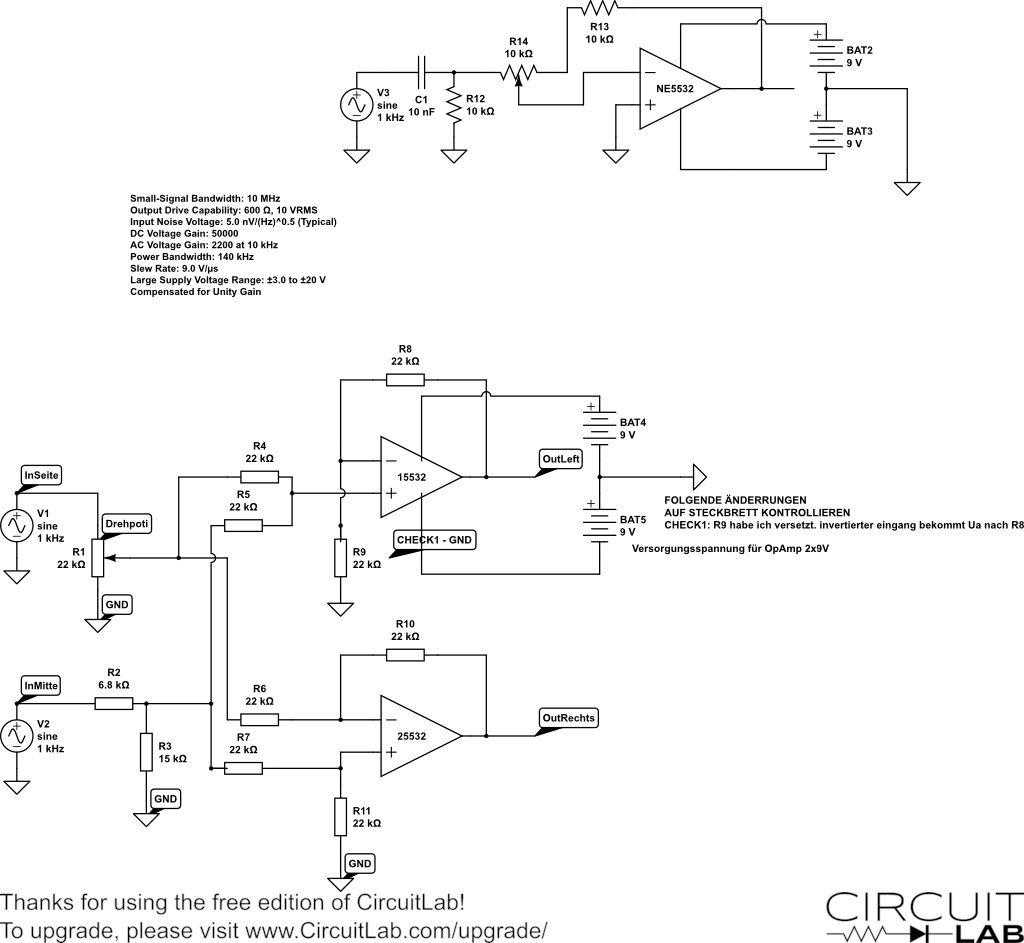How to sum and subtract signals? L+R and L-R. Phase?
|
I wanted to ask some help here. I opend a post a couple days ago: http://guitar-fx-layouts.42897.x6.nabble.com/Stereo-overdrive-How-td48833.html But I've thought it would be better to open a new one. I'd love to know how to sum and subtract signals. So I can sum the two channels (L+R) and subtract one from another (L-R). I put in the linked topic this picture that looks to do that but I'm not sure:  Any hep is mooore than welcome :) Cheers! |
|
A lot depends on what you are trying to accomplish.
In general, summing two signals would be simply mixing them together, i.e. connecting both signals to the same piece of wire. How to do that in practice depends on where the signals are coming from and what you intend to do with them, but if you are combining stereo outputs you can often just use two resistors as a mixer: Feed both outputs through identical resistors and tie the far ends of those resistors together. The resistors are acting as buffers, preventing each signal from traveling backward through the opposing channel's output and causing interference. In practice, there will be some loss, so you may want to add an amplifier stage afterward to boost the signal back up. Subracting signals would be similar, but you have to invert one of the signals first. The output impedance of the inverter will probably not be identical to the output impedance of the stereo source, though, so in many cases you would want to process the uninverted one similarly to the inverted one. Again, depends on what you're trying to do. There are not a lot of common use cases for this process outside of FM transmission. From reading your links, I get the impression you want to try cylens stereo mix distortion method on a stereo guitar signal. Is that correct? If so, you would need to build two identical copies of the circuit you linked so you can convert L/R into mid/side (aka L+R/L-R), perform the distortion, then convert distorted mid/side back into L/R. The circuit at the very top of the image is just an op-amp inverter. You can ignore it. The mid/side converter is the bigger circuit below it, with two op-amps in it. In more detail: 1. Feed L into 'InMitte' and R into 'InSeite' of the first copy of the circuit. 2. Feed 'OutLeft' (mid) and 'OutRechts' (side) separately into identical distortion circuits. 3. Feed distorted mid into 'InMitte', and distorted side into 'InSeite' of the second copy of the circuit. 4. 'OutLeft' and 'OutRechts' of the second copy of the circuit are your distorted stereo signal. Do whatever you were planning to do with them. This is rather an advanced topic, and you are unlikely to find anyone in the stompbox world with experience doing this with a guitar signal, so you will probably have to do a lot of experimentation. If you want additional insight from someone else with such experience, you might have better luck on a synth forum, but I can't promise you that with any confidence. This would be a fairly big project for even the most experienced stompbox builder. I can't stress this part strongly enough: You will want to work all of the details out on a breadboard before you go ahead and build anything permanent. This is most certainly a design project, not just a build. You are trying something new, and you will almost certainly not get it just right the first time. Even if it works perfectly, you will probably want to tweak it for sonic optimization. Even then, you may like it less than the much simpler solution of simply feeding L and R into identical distortion circuits. You won't know until you try both. That being said, if you go through with this, you will certainly learn a great deal. I hope you will report your results back to us. Best of luck. |
|
Ey induction! I can't thank you enough for your replies.
Yes, I want to try the cylens method for guitar. I know that quick double board approach might be good enough, but as you said: you'll never know until you try. I got it touch with cylens and he linked me to a website with some schematics very similar to the ones I posted here. My knowledge is so tiny that I'm learning a lot. I didn't even know the basic op amp inverting/non inverting configuration and the sum/subtract concepts. Thank you :) I know so little that sometimes I don't know how/what to ask exactly. I think I'll build the two boards on vero and then test all the M/S thing on the breadboard. Of course I will let you know how it's going I really appreciate your words. |
«
Return to Open Chat
|
1 view|%1 views
| Free forum by Nabble | Edit this page |

